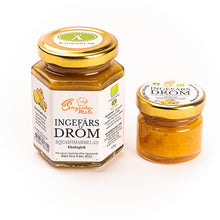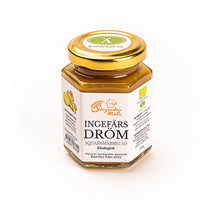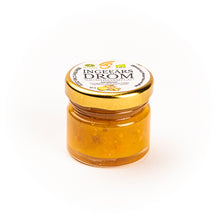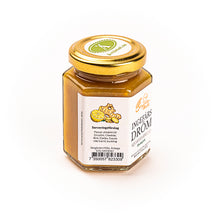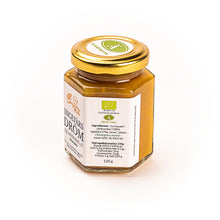
A fresh, tangy and delicious jam with its own place on the cheese tray, which also tastes great with chicken and smoked meat. Ginger jam can be served on bread, put on meat or eaten with rice or salads. Using a lot of ginger in a ginger jam can make it too spicy strong for some people, especially children. Therefore, we have experimented with the ingredients until we find a recipe that works like a dream for the whole family. It is made from yellow squash with the freshness of lemon and a light sting of ginger.
Ginger dream works with fruity wines, be they red or white. Try it with the Swiss cave-aged hard cheese Gruyère, which is a hard cheese with a lot of flavor that varies depending on whether it is made from summer or autumn milk, and of course on the aging time. Feel free to try it with a rhône wine, a sweet white wine or even a grappa.
Served at the Nobel Party 2016.
Goes well with Gruyère, Cheddar, Brie, Danbo, Gouda, smoked loin, chicken
Ginger is a hot, fragrant spice made from the rootstock, which can be chopped or powdered for cooking, preserved in syrup or candied. We use pressed organic ginger juice to bring out the right taste and sting.
Ginger dream is fantastic with smoked loin and with all kinds of chicken. You can also try Ingefärsdröm for Pots - a few spoonfuls in a pot gives an exciting taste experience! A chicken stew with coconut milk and ginger will take you to Thailand and India without having to buy any plane tickets. Soups – Carrot soup with a little ginger dream is a highlight and you can actually add it to many different types of vegetable soups. It is particularly good in winter as the strong taste contributes to the warm feeling the soup gives. Dessert – Ginger dream is super tasty with ice cream and with baked goods.
Ginger is a plant that has long been used for its healing properties. It has been widely used in traditional Chinese and Indian medicine for many hundreds of years, and here in Sweden it is common for home remedies for colds, nausea and pain to include ginger.
In ginger, there are several different components that contribute to the strong taste and aroma. Among other things, there are resin acids and essential oils. The specific taste that we have all come to love comes from the substance gingerol. But apart from that, there are a number of other subjects that are good for us.
Ginger is an herb that belongs to the ginger plant family. You probably recognize ginger as a root that looks quite similar to turmeric. But different from the turmeric, it is significantly larger and has a brown thin skin and a characteristic white/yellow inside. Another difference is that it has a very strong and specific taste and smell. As a spice, it is used for everything from Asian dishes to Swedish gingerbread.
In the kitchen, ginger is a good friend when we want to get a slightly stronger and refreshing taste. It is the root that is used when we cook and it can be used for many different things. Both the root and the leaves are used worldwide for healthy and tasty dishes. The leaves can also be used for cooking, but this is not as common in Sweden.
Yellow squash is summer squash, which is the young fruit of Cucurbita pepo and members of the Cucurbitaceae family. They share the family tree with Cantaloupe and cucumber and are cucumbers. There are two "types" of squash: summer squash and winter squash. What is the difference? The short answer is that a winter squash is a squash that is allowed to fully ripen. The seeds fully ripen and become hard, the skin becomes much thicker and the flesh is dense - and these fruits usually need to be cooked before you eat them. Most summer squashes have a bushy growth habit, unlike the vines of many winter squashes.
Summer squash is a little different. The seeds and peel are soft and fully edible. They are sometimes called "soft shell squash" and can therefore be cooked or eaten raw. The entire squash is edible, versus winter squash's hard seeds and skin that must be removed. The most common summer squash are yellow squash and zucchini.
One of their advantages is that they are completely edible. Yellow squash can be roasted, mashed, grilled or spiralized into spaghetti-like strands instead of pasta noodles. As the plant-based cuisine becomes more popular, you will find that yellow squash is an inexpensive option on the plate. It is a non-starchy vegetable, with few dietary restrictions.
Ingredients: Yellow squash, raw cane sugar (28%), ginger, lemon, pectin
Fruit amount 81 g per 100g
Nutrition declaration 100g: Energy 600 kJ/140 kcal; Fat 0.3 g (saturated fat 0.1 g); Carbohydrates 34 g (sugars 33 g); Protein 1 g; Salt 0.05 g









